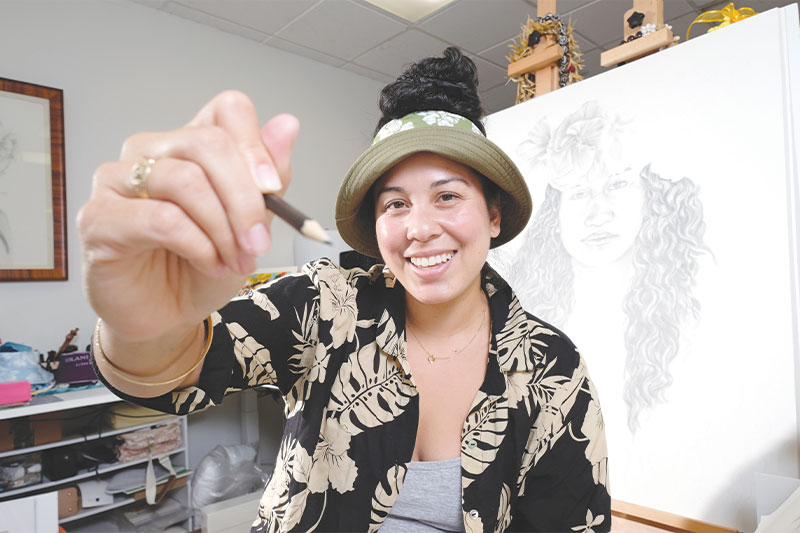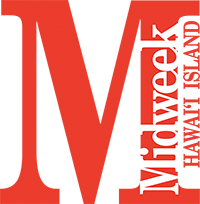Accidental Artist

Photo by Lawrence Tabudlo
JT Ojerio has reinvented herself, trading wrestling mats for sketch pads as the founder of Aloha de Mele and Studio Hale.
In just four years, JT Ojerio turned herself into a successful artist and entrepreneur. You can find her murals — a celebration of the local people and places she grew up around — at Hawai‘i Convention Center, in Kalihi-Pālama as part of the Hawai‘i Walls festival, in the Hawaiian Airlines flight attendants lounge and at Lanterns Restaurant and Tavern in Wai‘anae.
Her greeting cards, prints and accessories — adorned with vibrant, detailed illustrations of lei, blossoms and messy tita buns (Ojerio’s signature hairstyle) — are sold at local grocery stores, Bishop Museum and ‘Iolani Palace, among other places. She’s collaborated with Carissa Moore, Disney, Hurley and ALOHA Collection, to name a few.
Earlier this month, she took off on her first trip to Japan — to sell her wares at the Hankyu Hawai‘i Fair in Osaka.
Her trajectory is all the more impressive because she hadn’t initially set out to be an artist. She only began sketching in 2017, when she was in her mid-20s, and she didn’t take it seriously and post her work to Instagram until three years after that.
You see, before Ojerio had ever sketched a hibiscus, ‘ōlena blossom or lei po‘o, she’d been a standout athlete at Punahou School. During her middle school years, she went head-to-head with the boys on the football team.
“I wanted to prove a point,” she says with a laugh. “It was like, ‘Boys are soft! Watch me smack them down.’ Also, football players get all the attention and it’s not that hard.”
She backed off after freshman year, though, conceding the point when her teammates hit puberty. But it didn’t keep her away from contact sports — she just redirected her energy.
In high school, she competed in jiu-jitsu and joined the girls wrestling team, where she came face to face with Ilima-Lei Macfarlane. Although they are friends now, Ojerio says they didn’t get along in high school — perhaps because both were competitive and neither liked to back down.
Macfarlane went on to become a professional mixed martial artist (she was the inaugural Bellator women’s flyweight world champion) and at the time it seemed like Ojerio’s career path would also involve athletics.
In fact, Ojerio says when she attended her 15-year high school reunion earlier this year, her classmates told her, “We didn’t know you could draw!” Her response?
“Me either!”
After all, she’d taken just one drawing class at Punahou before leaving the islands to pursue sports-related credentials, eventually earning a master’s degree in exercise physiology and a certificate in pain medicine from University of Chicago.
Like many who go through a personal or professional transformation, Ojerio feels hers was brought on by what seemed, at the time, like an endless series of hardships.
She injured her hip and underwent major surgery. She began experiencing bouts of fatigue, tremors and migraines, and had her breast implants removed. That helped, but it was also one more surgery to recover from. She was homesick on the mainland and moved back to the islands — only to lose her job as a fitness practitioner soon after. And then came the COVID-19 pandemic.
Since she was still healing and the country was on lockdown, she took to sketching more frequently. Folks complimented her work, but she didn’t quite believe them because they were her parents, her friends or her husband. “They’re just being nice,” she told herself.
She even deflected attention onto her dog, a Cavalier King Charles spaniel named Mele, by joking that the pup was the artist. That’s how the name of her business came about — she signed her work “aloha de Mele,” or “aloha from Mele.”
“It took people who I don’t think actually liked me saying my art was nice,” she admits.
Once she began putting her work out there — sharing on Instagram, selling at craft fairs and farmers markets — she quickly picked up momentum.
She appeared on Talk Story with McKenna Maduli in December 2020.
“That was when I was like, ‘OK, I guess I have to actually be an artist now,’” she says. “People are expecting it.”
In 2021, she was picked for Mana Up’s sixth cohort. The accelerator program for companies producing Hawai‘i-based products helped her expand her business.
Today, Aloha de Mele has a brick-and-mortar workspace on Ala Moana Boulevard and Ojerio also owns and operates Studio Hale, which produces fine-art prints for local artists and organizations. She has two full-time employees — a studio manager and a printing manager — and recently hired a human resources company to handle payroll and compliance issues.
Her athlete’s mindset helps her on the business side of things.
“I run a tight ship (as far as) making the numbers and reaching goals and all of that,” she says.
But when it comes to being an artist, she admits to having moments of impostor syndrome.
“Sometimes, I feel like I’m just good at drawing, I’m not necessarily an artist,” she says. “When I hear my peers talk about the deep meaning (to their art) and they’re so eloquent with their description about how their abstract painting came about, I’m like, ‘Huh. Should I be like that? Should I have that type of magical thinking when really, it’s just me hyper-fixated on someone’s face?’”
Faces, she says, are her favorite thing to draw and the more real-to-life they are, the better. Perhaps that’s a nod to her science background.
“My art is very literal,” she says. “My background is in exercise physiology and the body, so I do understand the ratio of body parts and all of that.”
Putting “artist” down on her tax forms has helped alleviate some of her self-doubt and insecurities. It’s clear that art has changed the way she sees the world and given her experiences she would never otherwise have had.
“Even in terms of personality, it’s a totally different crowd that I hang out with now,” she says. “Artists are a bit more chill (than athletes), the way they see things is a lot different. Now, when I go to museums, I actually look at things differently. I feel like I try to understand the piece more, what went into it … versus, ‘OK, on to the next.’”
It’s also brought her closer to Native Hawaiian history and culture. Last year, she became one of the first people in decades to view Queen Lili‘uokalani’s patchwork quilt at ‘Iolani Palace without the protective acrylic case. Studio Hale had been given the opportunity to make high-quality prints of this one-of-a-kind piece of Hawaiian history. But first, Ojerio and her team had to take high-resolution photos of it.
“It was so epic,” Ojerio recalls. “We prayed beforehand. We made sure all the windows were closed and nobody could sneeze on it or anything like that. The mana in the room was crazy.
“I outsourced a scanning company to come in and we took the acrylic off the top of the quilt. We created a rig over it and took individual photos using a really fancy camera,” she continues. “We had to change it up so the flashes from the camera were brought down to half as strong so we wouldn’t damage (the quilt).
“It took all day, like a good six hours, and 12 of us to carry the acrylic off (the quilt) because it was boxed under so tightly. And, of course, the curators were watching us like hawks.”
‘Iolani Palace now sells high-resolution images of the queen’s quilt and can use the digital images for educational purposes. It also sells an exclusive line of Aloha de Mele products at its gift store.
As for the future, Ojerio wants to keep growing her businesses and refining her artistic skills. This includes building Studio Hale into a community gathering place for fellow creatives, selling her original drawings and paintings — “I’m too attached to them,” she admits — and maybe, one day, painting a Hawaiian Airlines plane.
“I would love to do that, if that’s even a thing,” she says. “That would be iconic.”
To learn more, visit alohademele.com and studiohale.com, and follow Ojerio on Instagram (@alohademele).

